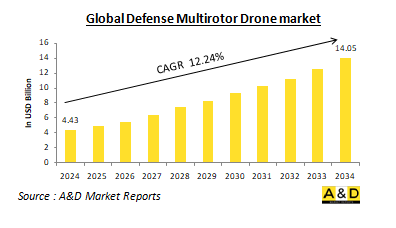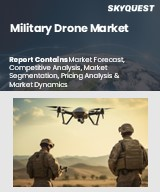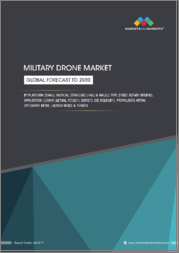
|
시장보고서
상품코드
1552530
세계의 방위용 멀티로터 드론 시장(2024-2034년)Global Defense Multirotor Drone Market 2024-2034 |
||||||
세계 방위용 멀티로터 시장은 2024년 44억 3,000만 달러로 추정되며, 예측 기간(2024-2034년) 동안 12.24%의 연평균 성장률(CAGR)로 확대되어 2034년까지 140억 5,000만 달러로 성장할 것으로 예상됩니다.

세계 방위용 멀티로터 드론 시장 개요
멀티로터 드론은 멀티로터 UAV(무인항공기)라고도 불리며, 현대 국방 전략의 필수적인 요소로 자리 잡고 있습니다. 멀티로터는 고정익이나 단일 로터 시스템보다 더 높은 안정성, 제어성 및 기동성을 제공하는 여러 개의 로터를 특징으로 합니다. 국방 분야에서 멀티로터 드론은 감시 및 정찰부터 직접 전투 및 후방 지원까지 다양한 임무에 활용되고 있습니다. 이 드론은 향상된 상황 인식을 제공하고, 인간 운영자의 위험을 줄이며, 중요한 실시간 정보를 제공함으로써 군사 작전에 혁명을 일으켰습니다. AI, 자동화, 소형화, 센서 통합과 같은 기술 발전으로 인해 국방 분야에서 멀티로터 드론의 채택이 가속화되고 있습니다. 멀티로터 드론은 항공기나 지상 차량과 같은 기존 군사 플랫폼에 비해 운영 비용 절감, 배치 용이성, 험난한 지형과 위험한 환경에서의 운용 능력 등 뚜렷한 이점을 제공합니다. 그 결과, 멀티로터 드론은 세계 국방 분야에서 중요한 위치를 차지하게 되었고, 다양한 국가들이 작전 능력과 전략적 효율성을 높이기 위해 자국 군에 도입하고 있습니다.
세계 방위용 멀티로터 드론 시장에서 기술의 영향력
기술의 발전은 국방 분야에서 멀티로터 드론의 개발과 보급에 매우 중요한 역할을 하고 있습니다. 이러한 기술은 드론을 단순한 정찰 도구에서 군사 작전에서 다양한 임무를 수행할 수 있는 다재다능한 시스템으로 탈바꿈시켰습니다. 멀티로터 드론에 가장 큰 기술적 영향을 미친 것 중 하나는 인공지능(AI)과 머신러닝(ML)의 통합으로, AI는 드론이 목표물 식별, 비행 경로 최적화, 실시간 의사결정 등 복잡한 작업을 자율적으로 수행할 수 있게 해줍니다. 할 수 있습니다. 또한, AI 기반 드론은 센서와 카메라의 방대한 데이터를 분석하여 지휘관에게 그 어느 때보다 빠르게 실용적인 인텔리전스를 제공할 수 있습니다. 이러한 실시간 처리 능력은 속도와 정확성이 임무의 성공을 좌우하는 현대전에서 매우 중요합니다. 또 다른 기술적 발전은 센서 시스템의 개선입니다. 최신 멀티로터 드론에는 첨단 카메라, 적외선 센서, LiDAR 및 기타 기술이 탑재되어 시야가 좋지 않은 상황에서도 목표물을 감지하고 추적할 수 있는 능력이 향상되었습니다. 이 능력은 드론이 인간 병사를 위험에 빠뜨리지 않고 적진이나 접근하기 어려운 지역에서 정보를 수집해야 하는 정찰 임무에서 특히 유용합니다. 이러한 센서와 AI 기반 분석을 결합하여 드론은 전장의 상세한 지도를 작성하고 잠재적 위협을 식별하여 정밀한 공격을 지원할 수 있습니다. 또한, 배터리 기술의 발전으로 멀티로터 드론의 작동 내구성이 향상되고 있습니다. 리튬 이온 배터리와 고체 배터리는 드론이 더 오래 비행하고 더 무거운 페이로드를 탑재할 수 있게 함으로써 다양한 방어 시나리오에서 유용성을 높이고 있습니다. 이러한 비행 시간 연장은 광역 순찰, 국경 감시, 군사 작전 중 지속적인 항공 지원과 같은 임무에 필수적입니다. 통신 시스템도 진화하여 안전하고 암호화된 통신 채널을 유지하면서 장거리에서 드론을 제어할 수 있게 되었으며, 5G와 위성 통신을 멀티로터 드론에 통합하여 더 빠른 데이터 전송과 장거리에서 더 안정적인 제어가 가능해졌습니다. 이러한 발전으로 드론은 도시 환경부터 외딴 지역과 적대적인 지역까지 다양한 환경에 배치할 수 있게 되었습니다.
세계 방위용 멀티로터 드론 시장의 주요 추진 요인
현대 전쟁의 복잡성, 기술 혁신, 군사 작전에서 상황 인식 강화의 필요성 등 여러 가지 요인이 세계 국방에서 멀티로터 드론의 성장과 발전을 촉진하고 있습니다. 전쟁의 진화는 비대칭 위협, 반란 전술 및 비 국가 주체의 부상을 도입하여 멀티로터 드론을 효과적인 솔루션으로 만들었습니다. 이 드론은 병사들을 불필요한 위험에 빠뜨리지 않고 정확한 정보 기반 작전을 가능하게 합니다. 표적 공격, 감시, 대테러 임무를 수행하며 현대 군사 전략에서 그 중요성을 확고히 하고 있습니다. 또한, 멀티로터 드론은 조달 및 운영 비용이 많이 드는 유인 항공기나 지상 차량과 같은 전통적인 군사 플랫폼에 대한 비용 효율적인 대안을 제공합니다. 드론은 조종사나 대규모 인프라의 필요성을 줄임으로써, 특히 상시 모니터링이 필요한 감시 및 정찰과 같은 작업에서 보다 경제적인 솔루션을 제공합니다. 멀티로터 드론의 주요 장점 중 하나는 인간의 위험을 줄이면서 위험한 작업을 수행할 수 있다는 점입니다. 지상 부대가 취약하거나 영공이 분쟁 중인 상황에서 드론을 정보 수집, 정밀 타격, 후방 지원에 투입하면 병사들의 위험을 최소화할 수 있습니다. 또한, 멀티로터형 드론의 높은 적응력도 촉진요인 중 하나입니다. 센서, 무기, 통신 장비 등 다양한 페이로드를 탑재할 수 있어 다양한 작전 환경에서 여러 기능을 수행할 수 있습니다. 다재다능한 만큼 새로운 기술로 업그레이드할 수 있어 국방부 입장에서는 미래지향적인 투자가 될 수 있습니다. 마지막으로, 지정학적 긴장이 고조되면서 국방 예산이 증가함에 따라 멀티로터 드론의 성장에 더욱 박차를 가하고 있습니다. 아시아태평양, 유럽, 중동 및 기타 지역의 국가들은 군사력 강화에 주력하고 있으며, 여기에는 멀티로터 드론과 같은 첨단 무인 시스템을 통한 군 현대화도 포함됩니다. 이러한 투자를 통해 각국은 점점 더 경쟁이 치열해지는 세계 환경에서 전략적 우위를 유지할 수 있습니다.
세계 방위용 멀티로터 드론 시장의 지역별 동향
방위용 멀티로터 드론에 대한 수요는 지역마다 크게 다르며, 지정학적 긴장, 국방비 지출, 지역 안보 우선순위 등의 요인에 영향을 받습니다. 북미, 특히 미국에서는 멀티로터 드론이 군사 작전에 필수적입니다. 미국 국방부는 육해공 작전에서의 우위를 유지하기 위해 드론 기술에 많은 투자를 하고 있습니다. 이 드론은 정보, 감시, 정찰(ISR) 임무뿐만 아니라 표적 공격과 대테러 활동에도 광범위하게 사용되고 있습니다. 미군은 기술 혁신과 AI 통합에 중점을 두고 있으며, 이를 통해 세계 드론 능력의 주도권을 확보하고 있습니다. 유럽에서는 NATO 국가들이 러시아의 군사 활동과 동유럽 분쟁과 같은 안보 문제에 대응하기 위해 멀티로터 드론에 대한 투자를 강화하고 있습니다. 유럽 국가들은 드론 기술을 통해 ISR 역량을 강화하고 국경을 초월한 협력을 강화하고 있습니다. 영국, 독일, 프랑스 등 국가들이 최전선에서 국경 보안, 평화 유지 임무, 대반란 작전에 멀티로터 드론을 배치하고 있습니다. 아시아태평양은 남중국해, 한반도, 인도-중국 국경에서 긴장이 고조되면서 국방 관련 드론 도입이 급증하고 있습니다. 중국, 일본, 인도, 한국 등 국가들은 군사력 강화를 위해 멀티로터 드론 기술에 많은 투자를 하고 있습니다. 특히 중국은 드론 시장의 중요한 기업로 국산 시스템을 개발하고 기타 국가에 드론을 수출하고 있습니다. 일본과 한국도 드론 기술을 통한 ISR과 대테러 작전의 발전에 집중하고 있습니다. 중동에서는 이스라엘, 사우디아라비아, UAE 등이 멀티로터 드론의 주요 소비국입니다. 이들 국가는 국경 보안, 대반란 작전, 중요 인프라 감시를 위해 드론을 사용하고 있습니다. 드론 기술에 대한 전문 지식으로 유명한 이스라엘은 다양한 지역에 방위 드론을 수출하는 세계 리더가 되었습니다. 아프리카와 라틴아메리카에서는 예산의 제약과 기술 인프라의 문제로 인해 드론 도입이 더 제한적입니다. 그럼에도 불구하고 국경 보안, 반테러 및 평화 유지 임무를 위해 멀티로터 드론을 획득하는 것에 대한 관심이 증가하고 있습니다. 기술 비용이 낮아지고 세계 협력이 강화됨에 따라 이 지역의 더 많은 국가들이 국방 전략에 멀티로터 드론을 도입할 것으로 예상됩니다.
방위용 멀티로터 드론의 주요 프로그램
영국, 우크라이나에 영국산 Malloy T150 쿼드콥터 화물용 드론을 납품합니다. 영국 정부는 우크라이나에 3 억 7,500만 달러의 새로운 지원을 약속했으며, 여기에는 대 배터리 레이더 기술과 전자전 장비가 포함됩니다. 영국 기업 Malloy Aeronautics는 T150 쿼드콥터 드론을 발명하고 제조했습니다. 이 드론은 식량, 물, 예비 부품, 탄약, 장비, 연료, 탄약 및 기타 전투원이 적지에서 생존하는 데 필요한 모든 장비를 공급하는 것을 목표로 합니다. 한 명의 병사는 노트북이나 태블릿을 사용하여 지도상의 위치를 가리키고 비행 경로를 탐색하여 전기로 구동되는 T150을 조작할 수 있습니다. 이 드론의 최대 항속거리는 70km이며, 최대 68kg의 페이로드를 탑재할 수 있고, 1회 비행시간은 최대 36분입니다.
터키 기업이 멀티로터 소형 UAV를 인도에 수출할 준비가 완료되었습니다. Ankara에 위치한 Zyrone Dynamics는 멀티로터 미니 UAV 모델을 개발하고 해외에서 융자를 받아 수출 준비가 완료되었으며, Anadolu Agency(AA)가 발표한 보고서에 따르면, 최첨단 기술로 특징적인 UAV 솔루션을 제공하는 Zyrone Zyrone Dynamics는 인도에 첫 제품을 선적할 준비를 하고 있으며, 인도의 DCM Shriram Industries가 350만 달러에 사업부문의 30%를 인수했다고 밝혔습니다. 처음으로 수출할 예정입니다. 내년에는 100대에 가까운 차량을 납품할 예정입니다. 이 사업은 인도를 통해 극동 국가로 확장할 계획이며, 인도에서는 국방 입찰을 위한 시범 비행도 진행할 예정입니다.
목차
방위용 멀티로터 드론 시장 : 보고서 정의
방위용 멀티로터 드론 시장 분석
- 지역별
- 용도별
- 항속거리별
방위용 멀티로터 드론 시장 분석(향후 10년간)
방위용 멀티로터 드론 시장 기술
세계의 방위용 멀티로터 드론 시장 예측
방위용 멀티로터 드론 시장 : 지역별 동향과 예측
- 북미
- 시장 성장 촉진요인 및 억제요인, 과제
- PEST 분석
- 시장 예측과 시나리오 분석
- 주요 기업
- 공급업체 Tier 상황
- 기업 벤치마킹
- 유럽
- 중동
- 아시아태평양
- 남미
방위용 멀티로터 드론 시장 : 국가별 분석
- 미국
- 방위 계획
- 최신 동향
- 특허
- 현재의 시장 기술 성숙도
- 시장 예측과 시나리오 분석
- 캐나다
- 이탈리아
- 프랑스
- 독일
- 네덜란드
- 벨기에
- 스페인
- 스웨덴
- 그리스
- 호주
- 남아프리카공화국
- 인도
- 중국
- 러시아
- 한국
- 일본
- 말레이시아
- 싱가포르
- 브라질
방위용 멀티로터 드론 시장 : 시장 기회 매트릭스
방위용 멀티로터 드론 시장 : 조사에 관한 전문가의 견해
결론
Aviation and Defense Market Reports에 대해
LSH 24.09.23The Global Defense Multirotor Market is estimated at USD 4.43 billion in 2024, projected to grow to USD 14.05 billion by 2034 at a Compound Annual Growth Rate (CAGR) of 12.24% over the forecast period 2024-2034

Introduction to Global Defense Multirotor Drones Market
Multirotor drones, also known as multirotor Unmanned Aerial Vehicles (UAVs), have become an integral part of modern defense strategies. They are characterized by multiple rotors, which provide greater stability, control, and maneuverability than fixed-wing or single-rotor systems. In defense applications, multirotor drones are utilized for a range of missions, from surveillance and reconnaissance to direct combat and logistical support. These drones have revolutionized military operations by offering enhanced situational awareness, reducing the risk to human operators, and providing critical real-time intelligence. The adoption of multirotor drones in defense has been accelerated by advancements in technologies such as AI, automation, miniaturization, and sensor integration. They offer distinct advantages over traditional military platforms, such as aircraft or ground vehicles, including lower operational costs, easier deployment, and the ability to operate in difficult terrains or dangerous environments. As a result, multirotor drones have gained significant importance in the global defense sector, with various countries incorporating them into their military forces to enhance their operational capabilities and strategic effectiveness.
Technology Impact in Global Defense Multirotor Drones Market:
Technological advancements have played a pivotal role in the development and proliferation of multirotor drones in defense. These technologies have transformed drones from simple reconnaissance tools into highly versatile systems capable of performing a wide variety of tasks in military operations.One of the most significant technological impacts on multirotor drones is the integration of artificial intelligence (AI) and machine learning (ML). AI enables drones to perform complex tasks autonomously, such as identifying targets, optimizing flight paths, and making real-time decisions without human intervention. AI-powered drones can also analyze vast amounts of data from sensors and cameras, providing commanders with actionable intelligence faster than ever before. This real-time processing capability is crucial in modern warfare, where speed and accuracy can determine the success of a mission. Another technological advancement is the improvement in sensor systems. Modern multirotor drones are equipped with advanced cameras, infrared sensors, LiDAR, and other technologies that enhance their ability to detect and track targets, even in low-visibility conditions. This capability is particularly valuable in reconnaissance missions, where drones need to gather information from hostile or hard-to-reach areas without exposing human soldiers to danger. The combination of these sensors with AI-driven analysis allows drones to create detailed maps of battlefields, identify potential threats, and support precision strikes. Furthermore, improvements in battery technology have extended the operational endurance of multirotor drones. Lithium-ion and solid-state batteries now allow drones to fly longer and carry heavier payloads, increasing their utility in various defense scenarios. This increased flight time is essential for tasks such as patrolling large areas, monitoring borders, or providing continuous air support during military operations. Communication systems have also evolved, allowing drones to be controlled from long distances while maintaining secure, encrypted communication channels. The integration of 5G and satellite communications into multirotor drones enables faster data transmission and more reliable control over vast distances. These advancements ensure that drones can be deployed in a wide range of environments, from urban settings to remote and hostile regions.
Key Drivers in Global Defense Multirotor Drones Market:
Several factors are driving the growth and development of multirotor drones in global defense, including the increasing complexity of modern warfare, technological innovation, and the need for enhanced situational awareness in military operations. The evolution of warfare has introduced asymmetric threats, insurgent tactics, and the rise of non-state actors, making multirotor drones an effective solution. These drones enable precise, intelligence-driven operations without exposing soldiers to unnecessary risk. They are instrumental in targeted strikes, surveillance, and counter-terrorism missions, solidifying their importance in modern military strategies. Additionally, multirotor drones offer cost-efficient alternatives to traditional military platforms like manned aircraft and ground vehicles, which are costly to procure and operate. By reducing the need for human pilots and large infrastructures, drones provide a more economical solution, particularly for tasks like surveillance and reconnaissance that require constant monitoring. One of the key advantages of multirotor drones is their ability to perform dangerous tasks while reducing the risk to human personnel. In situations where ground troops are vulnerable or airspace is contested, drones can be deployed to gather intelligence, conduct precision strikes, or provide logistical support, minimizing the risk to soldiers. Moreover, the adaptability of multirotor drones is another driving factor. They can be equipped with a range of payloads, including sensors, weapons, and communication devices, allowing them to serve multiple functions across various operational environments. Their versatility ensures they can be upgraded with new technologies, making them a future-proof investment for defense forces. Finally, the increase in defense budgets, driven by rising geopolitical tensions, has further fueled the growth of multirotor drones. Nations in regions such as the Asia-Pacific, Europe, and the Middle East are focusing on strengthening their military capabilities, which includes modernizing their forces with advanced unmanned systems like multirotor drones. These investments allow countries to maintain strategic advantages in increasingly contested global environments.
Regional Trends in Global Defense Multirotor Drones Market:
The demand for multirotor drones in defense applications varies significantly across regions, influenced by factors such as geopolitical tensions, defense spending, and regional security priorities. In North America, particularly the United States, multirotor drones are essential to military operations. The U.S. Department of Defense heavily invests in drone technologies to sustain its dominance in air, sea, and land operations. These drones are extensively used for intelligence, surveillance, and reconnaissance (ISR) missions, as well as for targeted strikes and counter-terrorism efforts. The U.S. military's focus on technological innovation and AI integration ensures its leading position in global drone capabilities. In Europe, NATO countries are ramping up their investment in multirotor drones to address security challenges like Russian military activity and conflicts in Eastern Europe. European nations are enhancing their ISR capabilities and improving cross-border cooperation through drone technology. Countries such as the United Kingdom, Germany, and France are at the forefront, deploying multirotor drones for border security, peacekeeping missions, and counter-insurgency operations. The Asia-Pacific region is witnessing rapid growth in defense-related drone adoption due to escalating tensions in the South China Sea, the Korean Peninsula, and along the India-China border. Nations like China, Japan, India, and South Korea are heavily investing in multirotor drone technology to enhance their military capabilities. China, in particular, is a significant player in the drone market, developing indigenous systems and exporting drones to other countries. Japan and South Korea are also focusing on advancing their ISR and counter-terrorism operations through drone technology. In the Middle East, countries such as Israel, Saudi Arabia, and the UAE are leading consumers of multirotor drones. These nations use drones for border security, counter-insurgency operations, and monitoring critical infrastructure. Israel, renowned for its expertise in drone technology, has become a global leader in exporting defense drones to various regions. In Africa and Latin America, drone adoption is more limited due to budgetary constraints and technological infrastructure challenges. Nonetheless, there is growing interest in acquiring multirotor drones for border security, anti-terrorism, and peacekeeping missions. As the costs of technology decrease and global collaboration increases, it is expected that more countries in these regions will incorporate multirotor drones into their defense strategies.
Key Global Defense Multirotor Program:
UK to deliver British-made Malloy T150 quadcopter cargo drones to Ukraine. The British government has committed $375 million in fresh aid for Ukraine, which includes counter-battery radar technology and electronic warfare equipment. Malloy Aeronautics, a British business, invented and produced the T150 quadcopter drone. The drone is intended to supply food and water, spare parts, ammunition, gear, fuel, ammo, and any other equipment that combatants may require to survive in hostile environments. A lone soldier may operate the electrically powered T150 by utilising a laptop or tablet to navigate its flight path by pointing at places on a map. The drone has a maximum range of 70 km and can carry a payload of up to 68 kg. It can fly for up to 36 minutes at a time.
Multirotor mini UAV by Turkish company ready for export to India. Zyrone Dynamics, a business located in Ankara, has created a multirotor mini-UAV model that is now ready for export after securing foreign financing. Zyrone Dynamics, which provides distinctive UAV solutions with its cutting-edge technology, is reportedly getting ready to ship its first product to India, according to a report published by Anadolu Agency (AA). For $3.5 million, the Indian company DCM Shriram Industries purchased 30% of the business. Before the end of the year, Zyrone Dynamics will export the ZCQM small multirotor UAV platform for the first time. Next year, the business anticipates delivering close to 100 automobiles. The business intends to grow to Far East nations via India and will also conduct demonstration flights for the defence bids in India.
Table of Contents
Defense Multirotor Drone Market Report Definition
Defense Multirotor Drone Market Segmentation
By Region
By Application
By Range
Defense Multirotor Drone Market Analysis for next 10 Years
The 10-year Defense Multirotor Drone Market analysis would give a detailed overview of Defense Multirotor Drone Market growth, changing dynamics, technology adoption overviews and the overall market attractiveness is covered in this chapter.
Market Technologies of Defense Multirotor Drone Market
This segment covers the top 10 technologies that is expected to impact this market and the possible implications these technologies would have on the overall market.
Global Defense Multirotor Drone Market Forecast
The 10-year Defense Multirotor Drone Market forecast of this market is covered in detailed across the segments which are mentioned above.
Regional Defense Multirotor Drone Market Trends & Forecast
The regional Defense Multirotor Drone Market trends, drivers, restraints and Challenges of this market, the Political, Economic, Social and Technology aspects are covered in this segment. The market forecast and scenario analysis across regions are also covered in detailed in this segment. The last part of the regional analysis includes profiling of the key companies, supplier landscape and company benchmarking. The current market size is estimated based on the normal scenario.
North America
Drivers, Restraints and Challenges
PEST
Market Forecast & Scenario Analysis
Key Companies
Supplier Tier Landscape
Company Benchmarking
Europe
Middle East
APAC
South America
Country Analysis of Defense Multirotor Drone Market
This chapter deals with the key defense programs in this market, it also covers the latest news and patents which have been filed in this market. Country level 10 year market forecast and scenario analysis are also covered in this chapter.
US
Defense Programs
Latest News
Patents
Current levels of technology maturation in this market
Market Forecast & Scenario Analysis
Canada
Italy
France
Germany
Netherlands
Belgium
Spain
Sweden
Greece
Australia
South Africa
India
China
Russia
South Korea
Japan
Malaysia
Singapore
Brazil
Opportunity Matrix for Defense Multirotor Drone Market
The opportunity matrix helps the readers understand the high opportunity segments in this market.
Expert Opinions on Defense Multirotor Drone Market Report
Hear from our experts their opinion of the possible analysis for this market.
Conclusions
About Aviation and Defense Market Reports



















